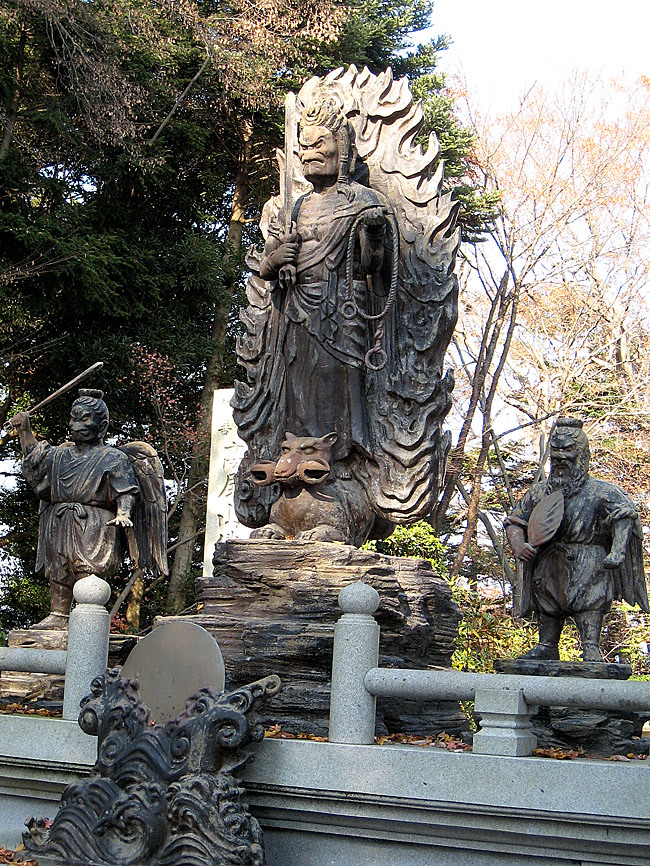Izuna Daigongen, literally, the Great Avatar of Izuna is regarded as the current ruler of Mt. Takao virtually ousting Yakushi Nyorai, literally, Healing Buddha (Bhaisajyaguru in Sanskrit), the original ruler of Mt. Takao.
We could say that the statue of Izuna Daigongen is a deformed Buddhist statue.
Izuna Daigongen was originally a Shinto deity called Ohtonoji no Mikoto.
According to the Manifestation Theory, Izuna Daigongen is considered a manifestation of Dainichi Nyorai, literally, Great Sun Buddha (Mahavirocana in Sanskrit).
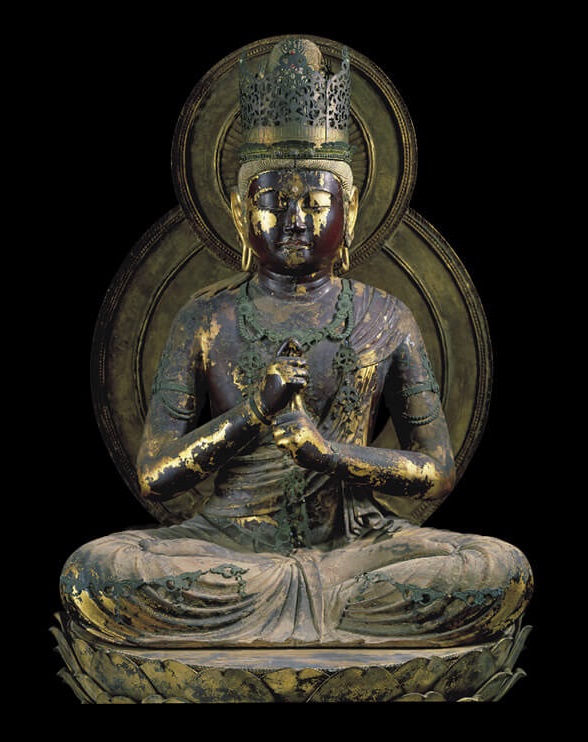
The Manifestation Theory in this context refers to the theory used as a rationale for the fusion of Shinto and Buddhism that Shinto gods should be considered manifestations of Nyorai (Buddha in Sanskrit), Bosatsu (Bodhisattva in Sanskrit), Myo-o (Vidyaraja in Sanskrit) and Buddhist guardian deities called Ten (Deva in Sanskrit).
As mentioned above, there are generally four (4) main categories of Buddhist statues.
Firstly, Nyorai (Buddha) are the highest in rank.
They are beings who have attained the state of spiritual enlightenment being free from 108 worldly sins or desires.
The most famous Buddha is Shakyamuni, the founder of Buddhism.
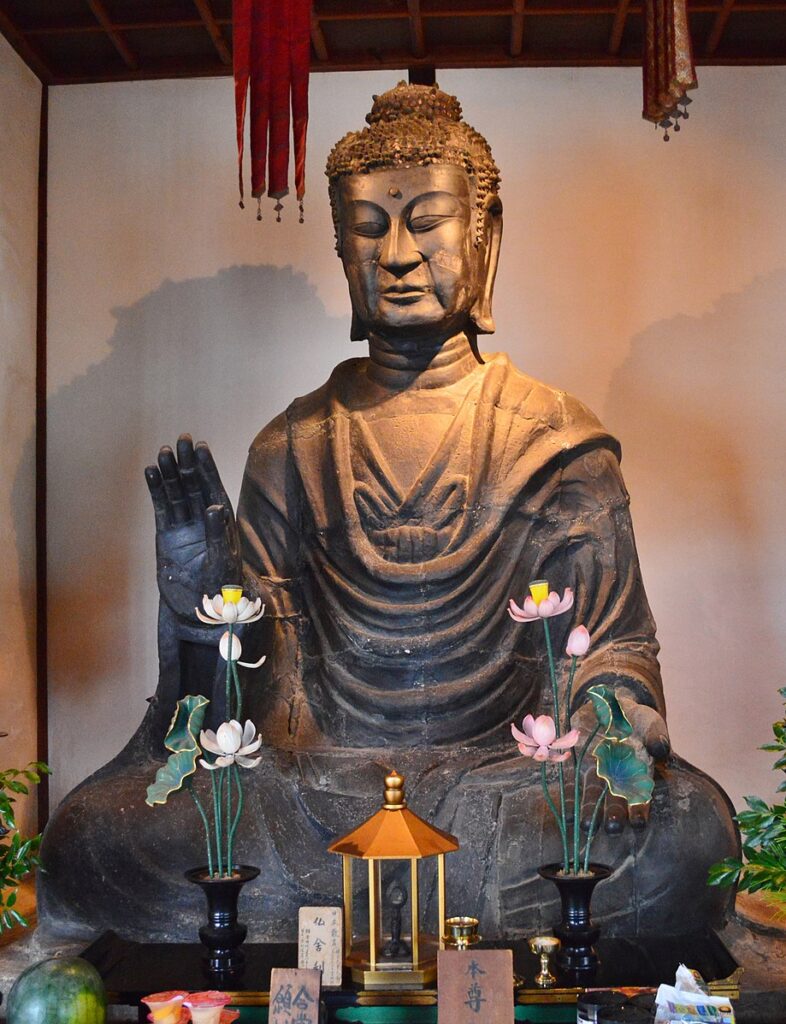
Shakyamuni is considered the highest ranking Buddha in Zen Buddhism that was introduced from China in the 13th century.
The teachings of Zen Buddhism were widely accepted among the samurai class because of their emphasis on the importance of self-discipline as well as physical and mental training.
As you can imagine, on the battlefield, it should be more true that Heaven helps those who help themselves.
Other Buddhas include such as Amida Nyrai (Amitabha), who is the ruler of the Western Buddhist Paradise and leads people there, and Yakushi Nyrai (Bhaisajyaguru) who is the ruler of Eastern Buddhist Paradise and its statue was the original principal object of worship at Yakuo-in Temple in Mt. Takao.
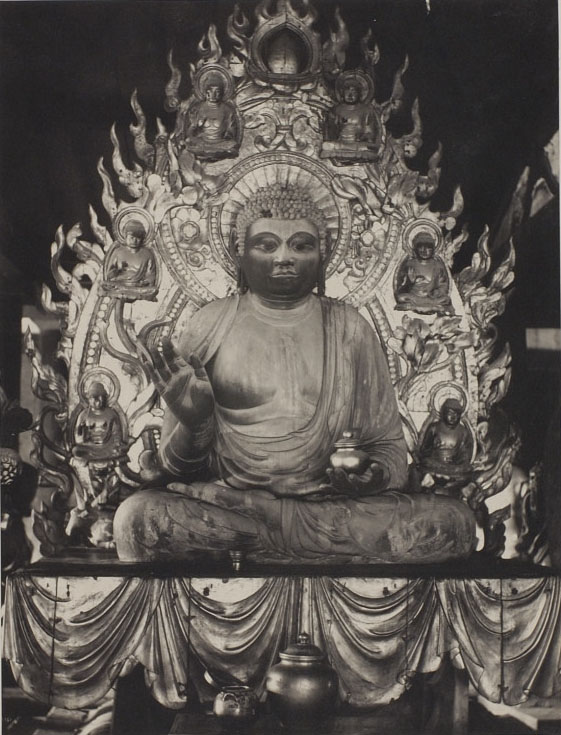
Amitabha Buddha is considered the highest ranking Buddha in the Pure Land sect of Buddhism that flourished in the Kamakura period spreading among all different social classes including common people since its theories were very simple and easy to understand.
Based on its principle, everybody can achieve the salvation by strongly believing in Amitabha Buddha, in practice, simply by reciting Namu Amidabutsu, literally, Devotion to Amitabha Buddha.
The Great Buddha of Kamakura is the statue of Amitabha Buddha.
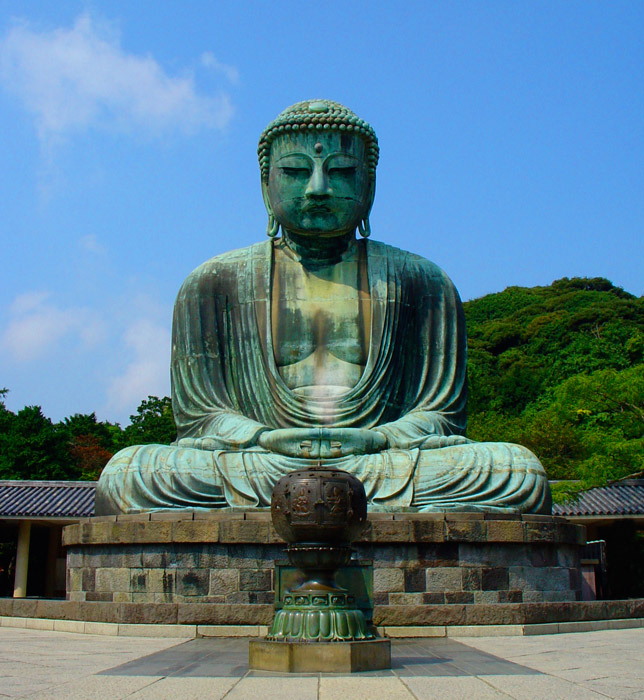
Different Buddha statues are used by different Buddhist sects.
In fact, it is sometimes very difficult to distinguish statues of various Buddha.
For instance, in the precincts of Kotoku-in Temple in Kamakura where the statue of Great Buddha is enshrined, there is a stone monument engraved with Waka-poem (31-syllable Japanese classical verse form) made by the notable Japanese female poet, Akiko Yosano (1878 – 1942) .
It says: “Kamakura ya Mihotoke naredo Shakyamuni wa Binan ni owasu Natsukodachi kana”.
The English translation is roughly as follows:
Here in Kamakura, the sublime Shakyamuni Buddha is of the other world, but what a good-looking man he is, adorned with the green of summer.
As you may be aware, she made a big mistake here.
As mentioned above, this Great Buddha in Kamakura is not the statue of Shakyamuni Buddha but the statue of Amitabha Buddha.
Actually, we can tell which is the statue of Shakyamuni Buddha or Amitabha Buddha from its mudras that is a set of hand gestures and finger positions.
In Japan, there is an expression O-shaka ni naru, which literally means turning out Shakyamuni Buddha, which effectively means turning out a lemon or a defective product.
This expression comes from the story that a client asked a casting manufacturer to make a statue of Amitabha Buddha but the casting manufacturer made a mistake in designing the mudra or hand gestures of the statue to end up making a statue of Shakyamuni Buddha.
In the Shingon sect of Buddhism that Yakuo-in Temple officially belongs to, Dainichi Nyorai (Mahavairocana) is the primordial Buddha and is considered the universe itself.
In that context, the other Buddhas such as Shakyamuni, Amitabha and Bhaisajiyaguru are, respectively, considered an avatar of Dainichi Nyorai (Mahavirocana).
Except for Dainichi Nyorai (Mahavirocana) which is depicted as a monarch wearing a crown and accessories, the statue of Buddha is depicted modeled on the image of Shakyamuni after he entered into priesthood wearing a simple costume which appears to fit in with the tropical India.
Bosatsu (Bodhisttva) are the second highest in rank.
They are beings who are working towards attaining spiritual enlightenment or sacred ascetic monks appearing in the Buddhist scriptures.
They are prospective new Buddhas.
Except for Jizo Bosatsu (Ksitigarbha in Sanskrit) that is depicted as a Buddhist priest and Bato Kannonn (Hayagriva in Sanskrit) that is depicted as a horse-headed Buddhist statue, in most of the cases the statue of Bodhisattva is depicted modeled on the image of Shakyamuni as a prince of the Shakya clan before he entered into priesthood, wearing various ornaments such as a necklace, earrings, a bracelet, a precious crown, etc.
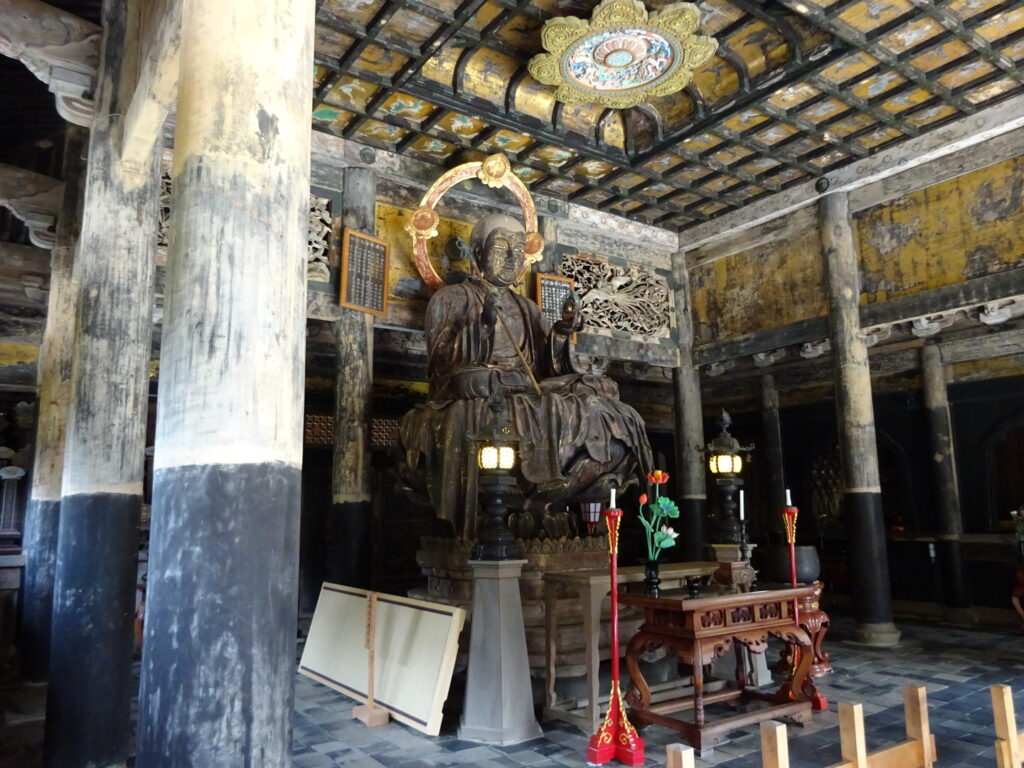
The most popular Bodhisattva is Kannon Bodhisattva (Avalokitesvara in Sanskrit), who has a warm smile and offers help to people with problems.
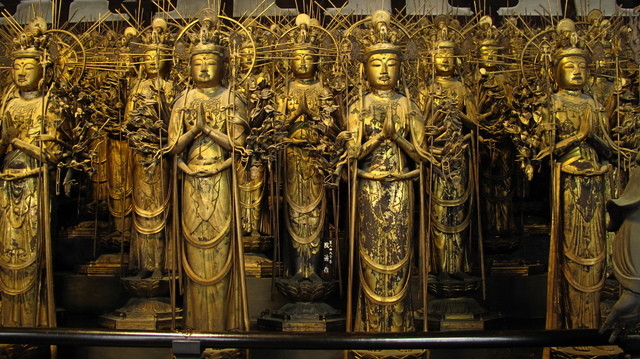
It is said that the name of camera manufacturer, Canon comes from Kannon Bodhisattva (Avalokitesvara).
In fact, their original company’s logo was designed with a motif of Thousand armed Kannon Bodhisattva (Sahasrabhuja Arya Avalokitesvara) with a wish that the company should be able to make the world best camera with the deep mercy of Kannon Bodhisattva.
Besides Buddha and Bodhisattva, there are also Myo-o, literally, Wisdom King (Vidyaraja in Sanskrit) and Ten (Deva in Sanskrit) acting as Buddhist guardian deities.
Myo-os (Vidyaraja) are supposed to punish those who ignore the Buddha’s teachings and forcibly guide those who cannot be educated by preaching only.
So, most of the statues of Myo-o (Vidyaraja) are depicted as scary-looking avatars of various Buddhas, with an angry expression.
Having said that, Kujaku Myo-o, a female Wisdom King (or Queen?) (Mahamayuri in Sanskrit, meaning the Great Peacock/Peahen) is an exception.
She has a warm smile and offers help to people by eliminating their three (3) major worldly desires that are likened to three poisons including greed, anger and ignorance among people.
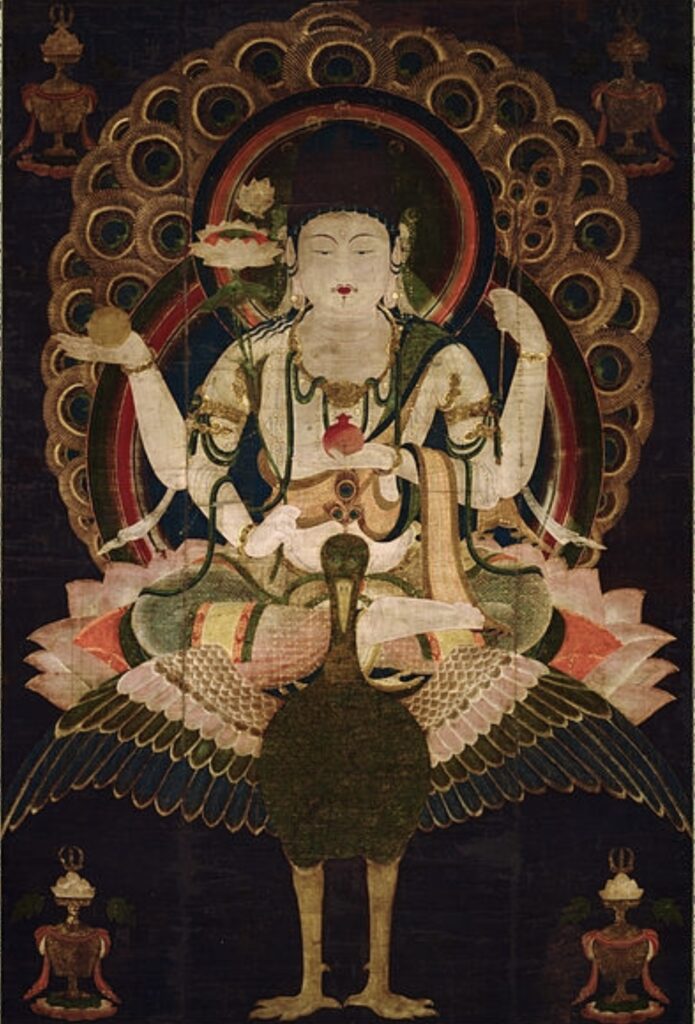
Kujaku Myo-o (Mahamayuri) is considered the product of imagination of people in ancient India fascinated by the mysterious power of peacock/peahen that prey on poisonous snakes and scorpions with the resistance to poisons.
In Mt. Takao, you cannot find the statue of Kujaku Myo-o (Mahamayuri) while instead you can find the facility made of stone (in front of the white Thai style stupa at Yuki-en) that will play the same role as Kujaku Myo-o (Mahamayuri) called meisantou, meaning a detoxification cylinder.
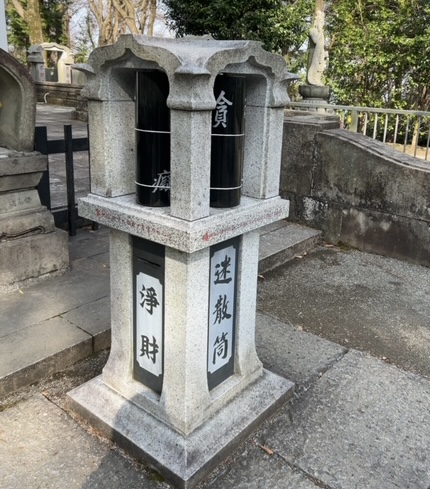
So, in Mt. Takao, you can easily eliminate your three (3) major worldly desires by rotating meisantou.
In addition to the Manifestation Theory, the Shingon sect of Buddhism Yakuo-in Temple officially belongs to, holds the theory called Sanrinjin (literally, three-wheel embodiments) which asserts that Nyorai (Buddha) will appear in other two (2) different figures, Bosatsu (Bodhisattva) or Myo-o (Vidyaraja), depending on the cultural level of the people he deals with to preach about Buddhist teachings.
That is, when Dainichi Nyorai (Mahavirocana) educates the people whose cultural level is reasonably high, he will appear in the form of Kongoharamitsu Bosatsu (Vajraparamita in Sanskrit) that is one of the avatars of Dainichi Nyorai (Mahavirocana).
On the other hand, when he educates the people who are too stubborn and difficult to be convinced to become believers in Buddhism by preaching only, he will appear in the form of Fudo Myo-o (Acalanatha) that is another avatar of Dainichi Nyorai (Mahavirocana).
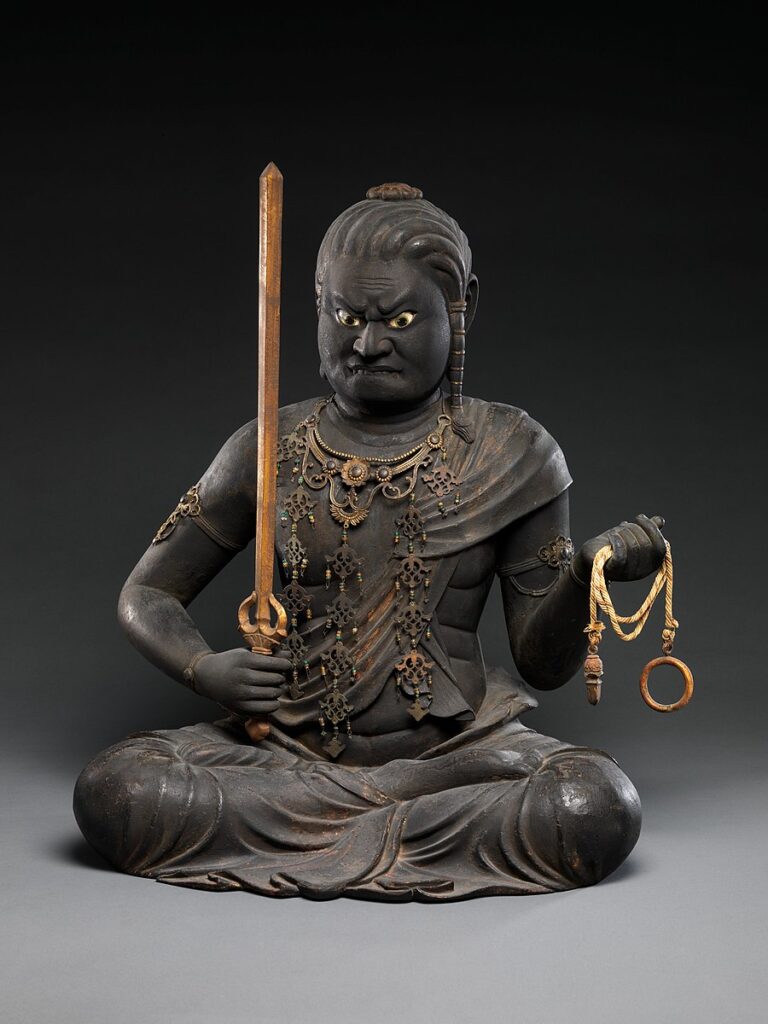
That is, when educating the people whose cultural level is too low, it should be more effective if Dainichi Nyorai (Mahavirocana) should appear in the form of a fierce looking Fudo Myo-o (Acalanatha) rather than in the form of Bodhisattva with a gentle smile.
Ten (Deva) are generally Indian gods and goddesses who have become Buddhist guardian deities.
All the guardian deities stationed at Buddhist style gates at Yakuo-in Temple in Mt. Takao are classified as Ten (Deva).
Among Ten (Deva), there are some of Chinese and Japanese origin.
The Shingon sect of Buddhism was introduced by Kobo Daishi (literally, the Great Priest Kobo) Kukai in the early 9th century from China and enjoyed immense popularity during the Heian period, particularly among the nobility, and contributed greatly to the art and literature of the time.
It is characterized by a system of Buddhist practices and teachings based on the mudras, mantras (Shingon in Japanese), and mandalas.
Mudras, as mentioned earlier, refer to symbolic gestures employed in Buddhism and many other religions, including Hinduism.
Mantras refer to syllables, words or verses recited with regular patterns of sound to tune in to a holy being such as Dainichi Nyorai (Mahavirocana).
Mandalas are visual representations of the universe in Buddhism.
Some of you may be familiar with these concepts through Yoga exercises.
It is worth visiting To-ji Temple in Kyoto, which is a part of the Historic Monuments of Ancient Kyoto UNESCO World Heritage Site (https://whc.unesco.org/en/list/688/), where you can appreciate a very impressive three dimensional mandala (a visual representation of the universe in the philosophy of the Shingon sect of Buddhism) consisting of twenty-one (21) Buddhist statues with the statue of Dainichi Nyorai (Mahavirocana) at the center in the Lecture Hall, which was made by the initiative of Kukai.
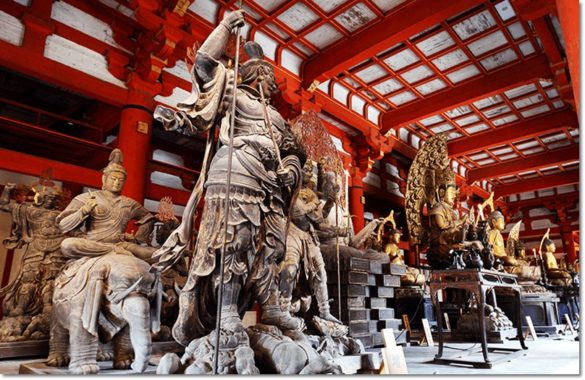
As mentioned earlier, Izuna Daigongen was originally a Shinto deity.
Shinto deities are in principle considered invisible while Yakuo-in Temple is originally a Buddhist temple.
So, they needed a Buddhist statue-like principal object of worship that depicts Izuna Daigongen.
Consequently, the image of Izuna Daigongen was created by combining Fudo Myo-o (Acalanatha) who is said to be the avatar of Dainichi Nyorai (Mahavirocana) with four (4) Buddhist guardian deities of Indian origin classified as Ten (Deva).
I suspect that this arrangement could mean that the role of Izuna Daigongen is expected to deal with the people whose cultural level is even lower.
Having said that, please don’t hesitate to visit Mt. Takao that will welcome you as well even if your cultural level is too high for Izuna Daigongen.
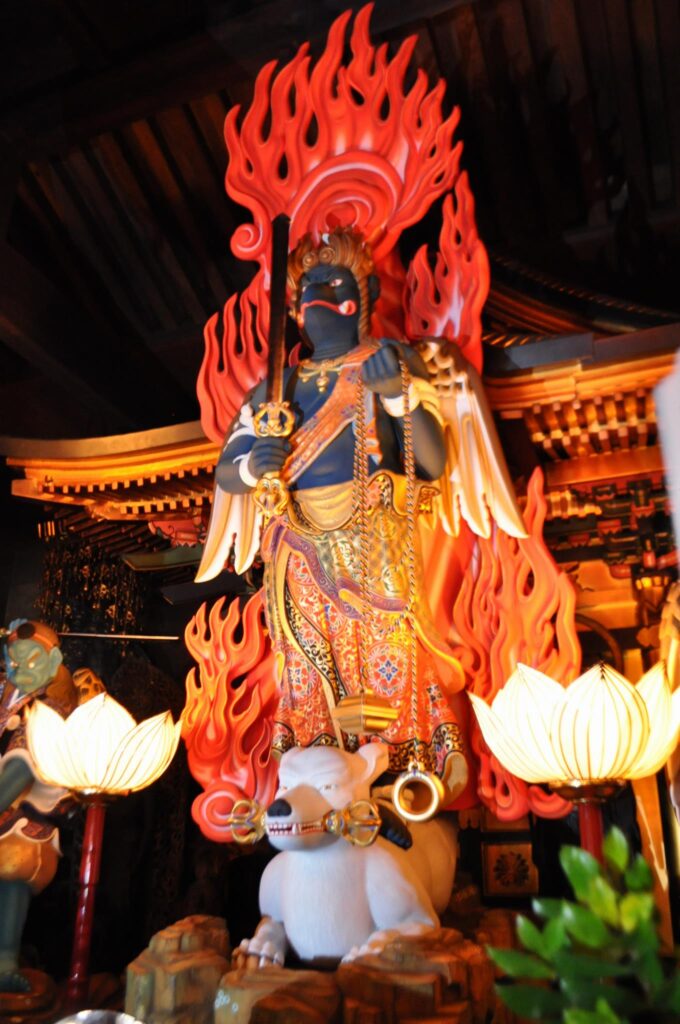
Four (4) Buddhist guardian deities of Indian origin combined with Fudo Myo-o are said to include Karura-ten (Garuda in Sanskrit), Dakini-ten (Dakini in Sanskrit), Benzai-ten (Sarasvati in Sanskrit) and Kangi-ten (Ganesh in Sanskrit).
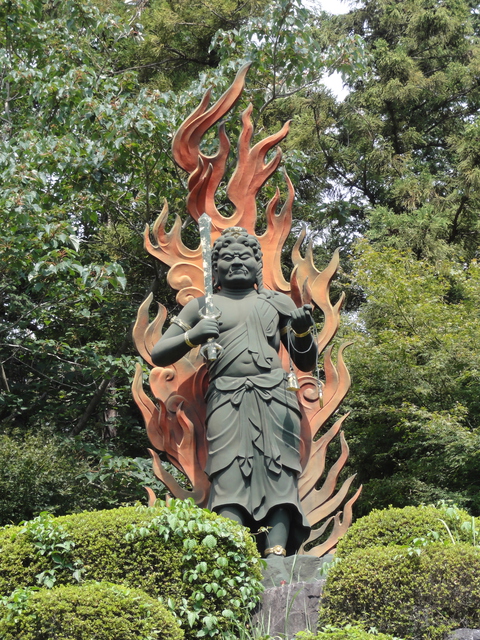
Like Fudo Myo-o (Acalanatha), Izuna Daigongen has a sword in his right hand and a rope called kensaku in his left hand with a halo of flames.
If you should have a closer look, the hair style of Izuna Daigongen is also the same as Fudo Myo-o (Acalanatha) with a long rope of hair hanging down the left side of the face and the left shoulder called a benpatsu.
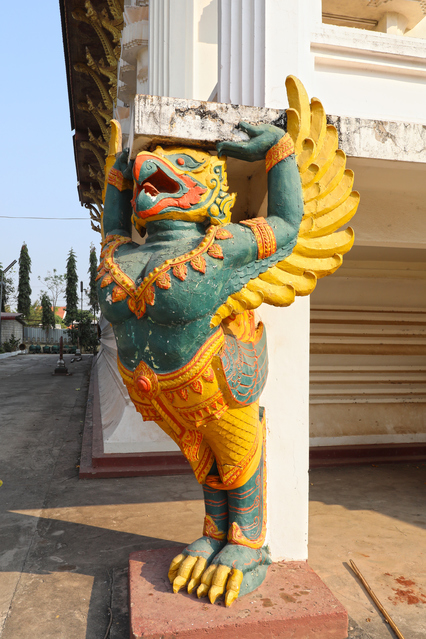
Like Karura-ten (Garuda) it has a birdlike head and wings.
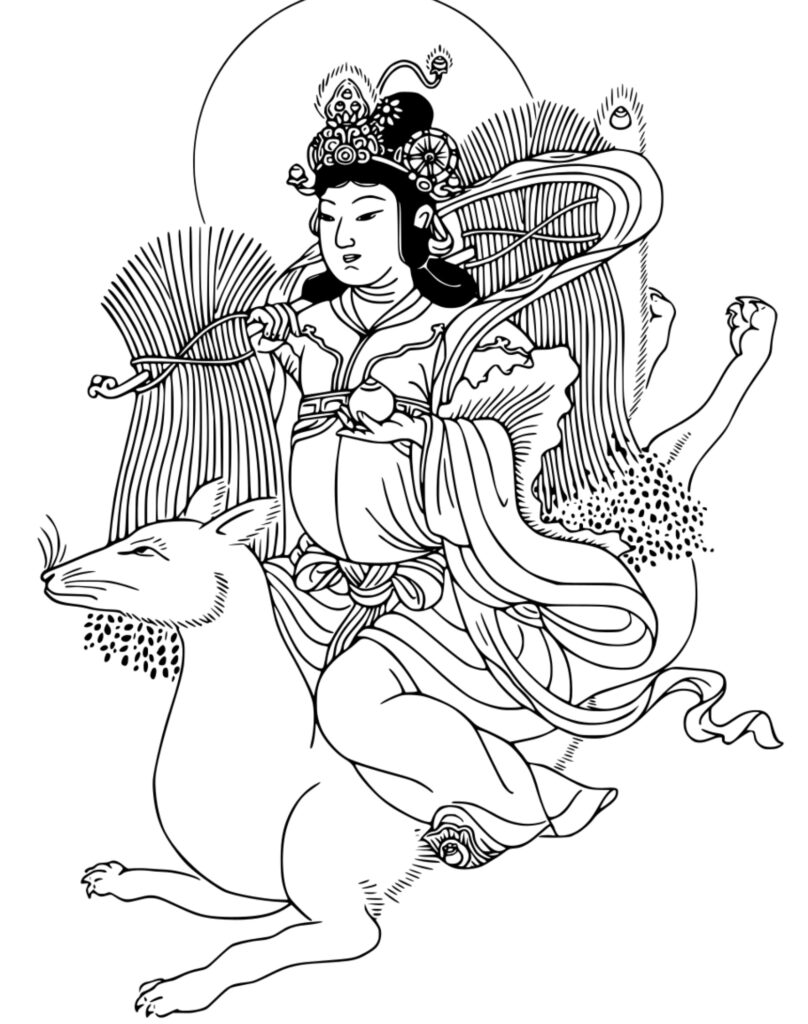
Like Dakini-ten (Dakini) it rides a white fox.
It is understood that in India Dakini is supposed to ride a jackal while Japanese people didn’t know a jackal and replaced it with a fox.
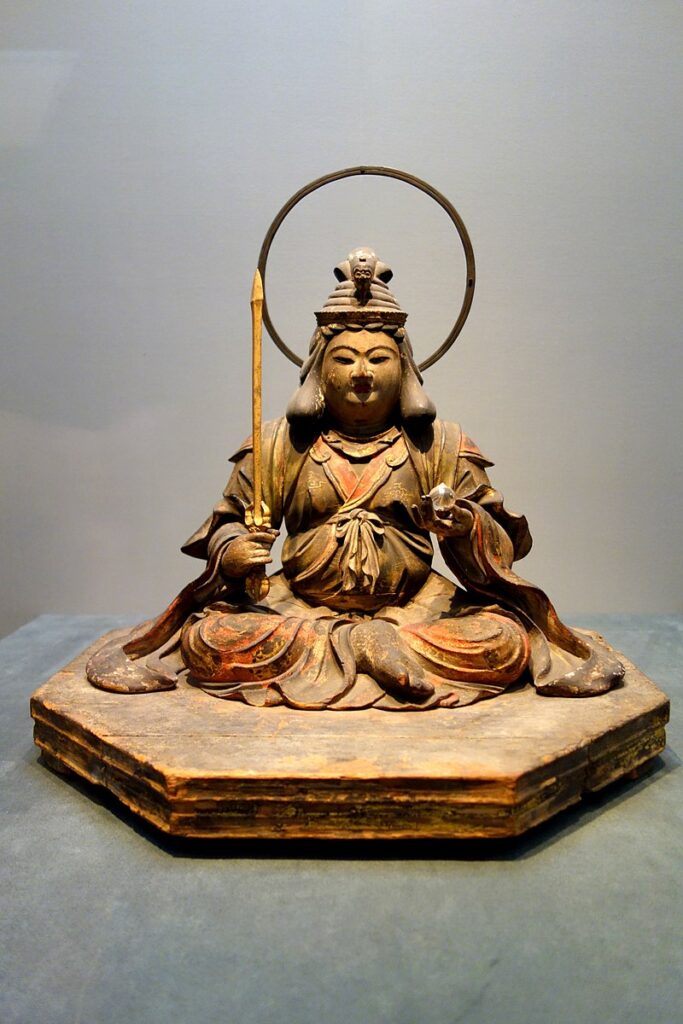
Small snakes that twine around the arms of Izuna Daigongen are said to indicate the connection with Benzai-ten (Sarasvati).
Snakes are the messengers of Benzai-ten (Sarasvati).
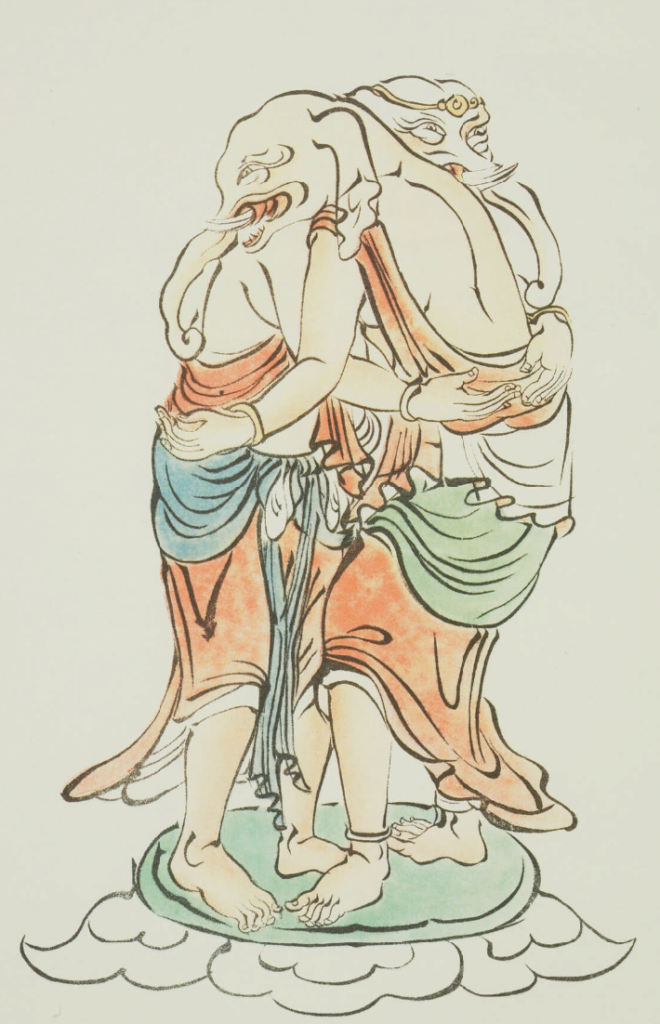
Izuna Daigongen is said to have the savage soul of Kangi-ten (Ganesh) who is the fertility deity with an elephant’s head.
The above painting depicts an elephant-headed male-female human couple standing in an embrace.
It is said that one of them is a transformed figure of eleven-headed Kannon Bodhisattva (Ekadasamukha in Sanskrit) who wears a crown and acts to quell the savage soul of Kangi-ten (Ganesh), who was originally a fierce god.
The fierce looking Izuna Daigongen surely appears to have the savage soul of Kang-ten (Ganesh).
As you may be aware, Japanese people have traditionally been very good at modifying various imported goods to create something new better adapted to the Japanese culture and society.
As you see, in order to create the statue of Izuna Daigongen, all the raw materials were imported from India.
We could say that the statue of Izuna Daigongen is one of the very good examples that embody the essence of Japanese culture.
